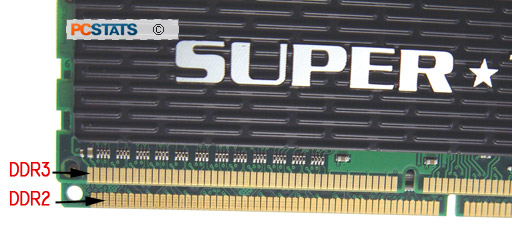|

|
The Mushkin memory that's up for testing today is its 2GB HP3-10666 (DDR3-1333) memory kit. By default the memory is rated to run at 1333 MHz with low CAS latency timings of 6-7-6-18, on a voltage of 1.7-1.8V.
86% Rating: 
|
|
|
|
Home >
Reviews >
Memory >
Mushkin HP3-10666 |
|
|
Understanding the Basic of DDR3 Memory
 DDR3 memory is not really expected to take hold until mid-2008, when
quad-core processors are basically mainstream chips. It's hard to say where AMD will stand on
all of this, its 'K10' microprocessor architecture is not expected to adopt DDR3 RAM
until 2009 according to the last report PCSTATS saw.
DDR3 memory is not really expected to take hold until mid-2008, when
quad-core processors are basically mainstream chips. It's hard to say where AMD will stand on
all of this, its 'K10' microprocessor architecture is not expected to adopt DDR3 RAM
until 2009 according to the last report PCSTATS saw.
In any case, as with all new memory standards
it's important to state the obvious to minimize confusion. While
DDR2 and DDR3 RAM Dual Inline Memory Modules (DIMMs) are physically the same size, and
contain the same number of little gold teeth (240), each class of memory is keyed
differently and so neither is interchangeable with the other socket.
DDR3 memory modules will not work in a DDR2 memory socket, even
if the motherboard chipset technically supports the DDR3 standard - as is the case with
the Intel P35 Express, and Intel X38 chipset. Conversely, DDR3 memory is not
backwards compatible with DDR2 memory slots.
One obvious difference between DDR-3 memory and its
predecessor is that DDR3 operates with less voltage. DDR-3 RAM requires 1.5V,
while DDR2 demands 1.8V power. Next, unique memory slots prevent DDR3 memory
from being installed in a DDR2 memory slot, and vice versa. The memory standards
themselves are not interoperable, so neither are the sockets.
|

These are 1.5V DDR3 memory slots. They look exactly like DDR2
slots, except for the 'key' which is in a slightly different position. Below is a DDR3
memory module over top of a DDR2 module. Note the subtle difference where
the DDR3 module is 'keyed' with respect to the DDR2 module. Both
memory standards have exactly 240 gold connectors, DDR3 operates at 1.5V,
DDR2 at 1.8V.
|
New memory standards are almost always made incompatible with old
ones. In this case it is because the voltage and data transfer architectures differ.
|

Placed edge to edge,
it is easy to see the physical difference between DDR2 and DDR3
modules. Where the module is 'keyed' is what separates the modules from bing installed
in the wrong slot.
| JEDEC standards dictate desktop DDR2 memory speeds to between
400-800 MHz, although chipset and memory manufacturers have pushed DDR2 speeds
much further. The JEDEC standard for DDR3 memory started at 800 MHz, running
officially as high as 1600 MHz. While there is a bit of overlap in terms of speeds,
it's not likely to last. At the moment most DDR3 memory is coming in two flavors,
1066 and 1333 MHz. The speed will increase as the memory standard
matures.
Let's get
started, overclocking is next!!
|
|
|
|
